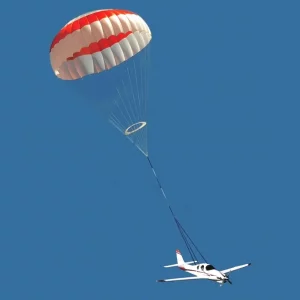


Aircraft Parachute Recovery System (APRS)
An Aircraft Parachute Recovery System (APRS) is a safety solution designed to help aircraft land safely during emergencies. The system typically includes several key components:
This system is commonly used in small aircraft, drones, and certain specialized aircraft to improve flight safety and reduce the risk of injury or fatalities during emergencies.
T181 Aircraft Parachute Recovery System (APRS)
The T181 is a high-performance aircraft parachute recovery system designed to slow the descent of an aircraft and allow for a safe landing in the event of a serious malfunction or loss of control. It uses ballistic ejection techniques and features an electrically initiated solid-fuel rocket for autonomous activation. Below are the key benefits:
The APRS significantly improves safety by enabling quick parachute deployment in emergencies such as engine failure, severe weather, or loss of control. It helps guide the aircraft to a safe landing, minimizing damage and reducing the risk of injury.
Traditional forced landings require precise conditions and expert techniques. The APRS simplifies this by allowing the pilot to deploy the parachute at the push of a button, ensuring a safe descent regardless of terrain or weather. This quick activation dramatically reduces response time in critical situations.
By slowing the descent, the parachute system reduces impact force and prevents serious damage to the aircraft. Unlike traditional emergency landings, which may result in severe damage, the parachute system ensures a controlled, steady landing, preserving the aircraft’s integrity and reducing repair costs.
The APRS can be customized for different types of aircraft, including small civilian planes, drones, and specialized aircraft. It is adaptable to varying altitudes and mission requirements, enhancing safety across a wide range of aviation applications.
The system’s rapid response capability is a major advantage. In an emergency, the pilot can deploy the parachute in seconds, providing immediate protection and allowing for a quick, safe landing. This quick action increases the likelihood of survival and minimizes risks in critical moments.
Copyright © 2021. All rights reserved. Cookie Policy | Privacy Policy
WhatsApp us